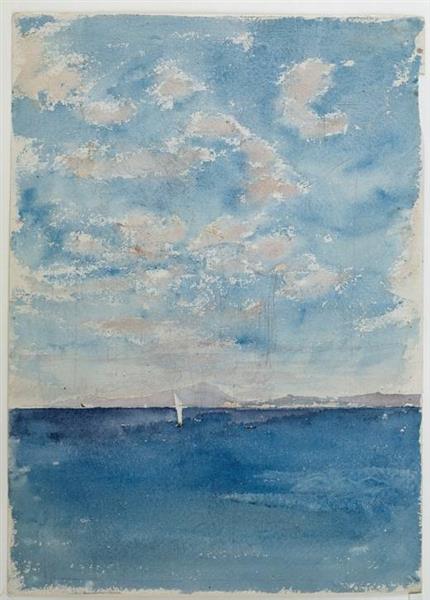Description
The work *Mar at the bottom of the Vesubio *, painted by Mariano Fortuny, is a clear example of the artist's mastery in the representation of the landscape and the Mediterranean atmosphere. Fortuny, born in 1838 in Reus, Spain, is one of the precursors of the orientalist style and known for its meticulous attention to the details and its vibrant use of color. In this painting, made between 1866 and 1867, it enters the concept of the sea and its symbiotic relationship with the volcano that dominates the Neapolitan landscape, the Vesubio, evoking a duality between the calm and the potential fury of nature.
The composition is structured with the sea in the foreground, which presents a serene sea, whose soft waves seem to reflect the light and vibrate with nuances that range between the intense blue and green. In the background, the majestic Vesubio, who with his conical shape rises on the horizon, creates a dramatic tension. The dynamics between the sea and the volcano is palpable; The first radiates tranquility while the second suggests the possibility of devastating power. This duality is one of the most fascinating characteristics of the work, perhaps reflecting the contradictions of life itself.
The use of color is especially notable. Fortuny uses a rich and varied palette that brings depth and luminosity to the scene. The soft touches of light that caress the waves give a feeling of movement and life, while the shadows of the Vesubio add an air of mystery. This technique, which combines realism with a loose and free brushstroke, is one of the distinctive firms of Fortuny, who was influenced by natural light and the study in Plein Air.
In terms of characters, the work lacks obvious human figures, allowing the viewer to submerge completely in the landscape. This decision reinforces the importance of the natural environment, raising the presence of the sea and the volcano in the artistic context. The absence of human subjects could be interpreted as a comment on the insignificance of man against the magnificence of nature, a common idea in the work of many romantic painters and symbolists.
However, the historical context of * Mar at the bottom of the Vesuvio * also deserves attention. Fortuny made several of his works while traveling and worked in Italy, where he captured the spirit of an era that sought to understand and represent nature more authentically. His inclination towards the representation of Mediterranean and Oriental themes is often found in his work, showing a deep love for the light and the characteristic color of these landscapes. This particular painting is aligned with its exploration of the contrast between the peaceful and the terrifying, a theme that resonated in the popular consciousness of the time due to the history of Vesubio and its devastating eruption.
Through *Mar at the bottom of Vesuvio *, Mariano Fortuny not only presents us with a landscape, but also invites us to reflect on the interrelation between the sea and the volcano, serenity and threat. The visual balance achieved in the work, together with its rich color, consolidates Fortuny as a master In the representation of the landscape, allowing this work to resonate with contemporary and future spectators, fascinated by continuous dialogue between natural elements.
KUADROS ©, a famous paint on your wall.
Hand-made oil painting reproductions, with the quality of professional artists and the distinctive seal of KUADROS ©.
Art reproduction service with satisfaction guarantee. If you are not completely satisfied with the replica of your painting, we refund your money 100%.

